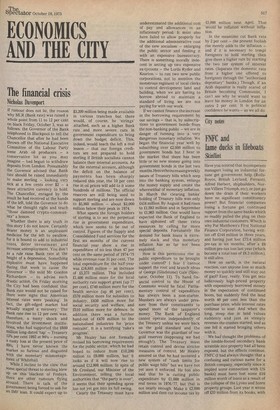City notes
FNFC and lame ducks in lifeboats
Skinflint
Have you noticed that incompetent managers losing an industrial fortune get government help (RollsRoyce, British Leyland, Ferranti, Alfred Herbert, shipbuilders, Norton Villiers Triumph, etc), or just go down the drain if their workers have no significant constituency power? But financial companies losing a fortune get continued support from the same banks which so readily pulled the plug on their own industrial customers. Which is why Pat Matthews's First National Finance Corporation, having written off £144 million in three years, and having just lost £73.4 million pre-tax in six months, after a £6 million pre-tax loss last year (which became a total loss of £8.3 million), is still alive.
How on earth, is the natural reaction, can anyone lose so much money so quickly and still stay out of gaol? Easy, really. You get into ludicrously high-priced property with expensively borrowed money in the expectation of continued boom, but suddenly find the land worth 40 per cent less than the purchase price, while interest rates continue to soar. And when the long, steep rise in land values suddenly and just as steeply reverses the crashes started; and as one fell it started bringing others with it.
We had thought the problems of the nimble-footed secondary bank scramble into property had all been exposed, but the effects continue. FNFC (I had always thought that a confusing and curious name for a British company, especially since it implied some connection with US banks) must have lost some £10 million worth of loans as a result of the collapse of the Lyons and Stern property groups. Last year it wrote off £33 million from its books, with £25 million as bad debts from the £224 million lent for house building, property development and commercial property. And the latest six-monthly accounts show another E70 million off the value of loans, £14 million off investments, and £7 million provision for guarantees. And though the announcement carefully refrained from spelling it out, FNFC's fortunes are still deteriorating. So there is more to come.
There is then a certain bitter irony in Pat Matthews, creator of FNFC's rise and fall, bravely riding to the rescue of foundering secondary bank London and County Securities last year. L&C was one of the first casualties among the feckless secondary banks and helping it may have cost FNFC another £5 million.
Now FNFC itself, as one of the largest occupants of the Bank of England's 'lifeboat', is the recipient of £360 million (almost Monopoly money, isn't it?) from the City. Only United Dominions Trust's £450 million can rival it. Which leaves little room for others in the £1,000 million lifeboat launched by the Bank to keep afloat the foundering City institutions and so preserve overseas London's dependable reputation. (Cliches get confusing: what are lame ducks doing in lifeboats?) The question remains — why do the joint stock banks put up their more carefully nurtured cash for reckless financial operators when they cheerfully send their own industrial customers into bankruptcy? The answer is that it is all much nearer home and they fear the domino effect thudding through the City, gaining momentum and perhaps crumbling the big four themselves. This effect is clearly visible in FNFC.
Funnily enough the gleam of hope in FNFC is the commercial credit, hire purchase, side which is still making profits, though in February the US Federal Reserve Board saw the mess FNFC had got into and prevented Chase Manhattan's proposed acquisition of half that operation. If Pat Matthews had not, like so many other City parvenus, been seduced by the apparent fortunes to be made from an extrapolated property boom, his shares might not have soared to the 353p of 1971, but they might have been above the 11/2p of last week.
There are, of course, obvious moralsOne is that nothing continues to soar indefinitely, and the more people there are artificially stoking a market for a quick killing the more imminent and steep will be its reversal. (That is also a chartist maxim.) The second moral is that loans can get more expensive as interest rates rise, but assets can depreciate which can put a company into a nasty squeeze. There is also something about eggs and baskets.



































 Previous page
Previous page